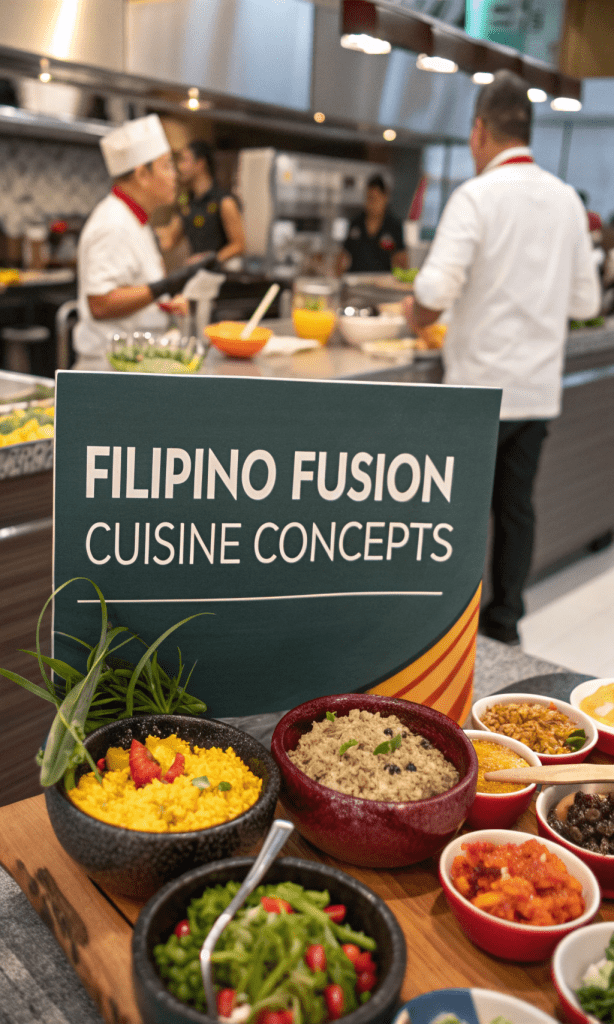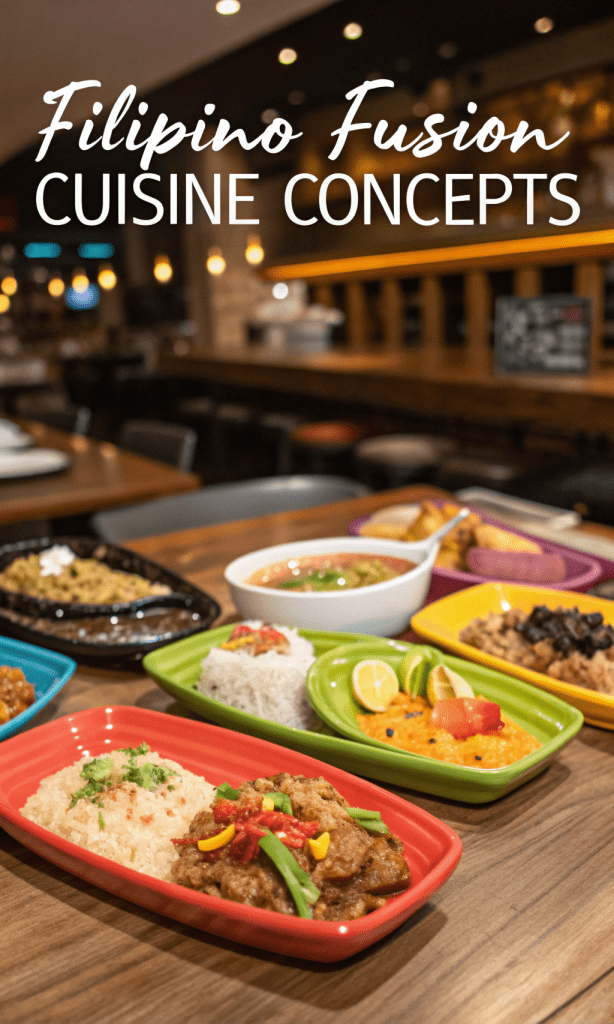
Filipino fusion cuisine concepts blend traditional Filipino flavors with global culinary influences, creating innovative dishes that excite the palate. This article explores the origins, preparation methods, nutritional benefits, and key elements of Filipino fusion cuisine. From its cultural roots to modern adaptations, discover how this dynamic cuisine captivates food enthusiasts worldwide.
What Are Filipino Fusion Cuisine Concepts?
Filipino fusion cuisine concepts combine the bold, tangy, and savory flavors of traditional Filipino dishes with techniques and ingredients from other cuisines, such as Japanese, Mexican, or Italian. This culinary approach celebrates the Philippines’ rich food heritage while embracing global influences. Think adobo tacos, sushi stuffed with longganisa, or pancit infused with Thai spices. These dishes honor Filipino traditions while introducing exciting twists.
Fusion cuisine thrives on creativity. Chefs experiment with ingredients, cooking methods, and presentations to craft unique dishes that appeal to diverse audiences. The result is a harmonious blend of flavors that feels both familiar and new.
Origins of Filipino Fusion Cuisine
Historical Roots
Filipino cuisine reflects the Philippines’ complex history. Indigenous ingredients like coconut, mango, and tamarind merge with influences from Spanish, Chinese, Malay, and American colonizers. For example, adobo, a classic Filipino dish, uses vinegar and soy sauce, showing Chinese and Spanish influences. This history of cultural blending sets the stage for modern Filipino fusion cuisine.
Global Influence and Modern Evolution
Filipino fusion cuisine gained traction in the 21st century as Filipino chefs and restaurateurs, particularly in the diaspora, began experimenting with global flavors. Cities like Los Angeles, New York, and Sydney, with large Filipino communities, became hubs for fusion restaurants. Chefs started pairing Filipino staples like pork sisig with American sliders or infusing lumpia with Korean bulgogi, appealing to multicultural diners.
The rise of social media and food blogs further popularized Filipino fusion cuisine. Instagram-worthy dishes, such as ube waffles topped with mango salsa, showcased the cuisine’s vibrant colors and bold flavors, attracting foodies worldwide.
Key Ingredients in Filipino Fusion Cuisine
Filipino fusion cuisine relies on a mix of traditional Filipino ingredients and global additions. Here are some staples:
- Ube: This vibrant purple yam adds color and sweetness to desserts, pancakes, and even savory dishes like ube gnocchi.
- Coconut Milk: A creamy base for curries, sauces, or fusion dishes like coconut ceviche.
- Calamansi: A tangy citrus fruit used in marinades, dressings, or cocktails.
- Patis (Fish Sauce): Adds umami to stir-fries, dips, or fusion ramen.
- Suka (Vinegar): A key component in adobo, now used in fusion vinaigrettes or pickles.
- Longganisa: Filipino sausage that enhances tacos, pizzas, or sushi rolls.
- Mango: Sweet and juicy, perfect for salsas, smoothies, or desserts.
Chefs pair these with global ingredients like avocado, kimchi, or burrata to create innovative dishes that bridge cultures.
How to Make Filipino Fusion Cuisine at Home
Creating Filipino fusion dishes at home is fun and approachable. Below are three recipes that showcase Filipino fusion cuisine concepts, blending traditional flavors with global twists.
Recipe 1: Adobo Tacos
Ingredients (Serves 4):
- 1 lb chicken thighs, boneless, cut into strips
- 1/4 cup soy sauce
- 1/4 cup white vinegar
- 4 cloves garlic, minced
- 1 bay leaf
- 1 tsp black pepper
- 1 tbsp olive oil
- 8 small corn tortillas
- 1 avocado, sliced
- 1/2 cup diced mango
- 1/4 cup chopped cilantro
- 1/4 cup crumbled queso fresco
Instructions:
- Marinate chicken in soy sauce, vinegar, garlic, bay leaf, and pepper for 30 minutes.
- Heat olive oil in a skillet over medium heat. Cook chicken until tender, about 10 minutes.
- Remove bay leaf. Shred chicken and return to skillet to soak up sauce.
- Warm tortillas. Fill each with chicken, avocado, mango, cilantro, and queso fresco.
- Serve with a squeeze of calamansi or lime.
Why It Works: The tangy, savory adobo pairs perfectly with creamy avocado and sweet mango, creating a Filipino-Mexican fusion that’s vibrant and satisfying.
Recipe 2: Ube Pancakes with Coconut Whipped Cream
Ingredients (Serves 4):
- 1 cup all-purpose flour
- 1/2 cup ube powder
- 1 tbsp baking powder
- 1/2 tsp salt
- 1 cup coconut milk
- 1 egg
- 2 tbsp sugar
- 1 tsp vanilla extract
- 1/2 cup heavy cream
- 2 tbsp coconut cream
- 1 tbsp powdered sugar
- Fresh mango slices for topping
Instructions:
- Mix flour, ube powder, baking powder, and salt in a bowl.
- Whisk coconut milk, egg, sugar, and vanilla in another bowl. Combine with dry ingredients.
- Heat a non-stick skillet over medium heat. Pour 1/4 cup batter for each pancake. Cook until bubbles form, then flip and cook for 2 more minutes.
- Whip heavy cream, coconut cream, and powdered sugar until soft peaks form.
- Stack pancakes, top with coconut whipped cream and mango slices.
Why It Works: Ube’s nutty sweetness shines in fluffy pancakes, elevated by tropical coconut cream and mango, blending Filipino and American breakfast traditions.
Recipe 3: Sisig Lettuce Wraps with Gochujang Aioli
Ingredients (Serves 4):
- 1 lb pork belly, diced
- 1 onion, chopped
- 2 cloves garlic, minced
- 1 red bell pepper, diced
- 2 tbsp soy sauce
- 2 tbsp calamansi juice
- 1 tbsp vegetable oil
- 8 lettuce leaves
- 1/4 cup mayonnaise
- 1 tbsp gochujang (Korean chili paste)
- 1 green onion, sliced
Instructions:
- Boil pork belly for 20 minutes, then drain and chop finely.
- Heat oil in a skillet. Sauté onion, garlic, and bell pepper until soft.
- Add pork, soy sauce, and calamansi juice. Cook until crispy, about 10 minutes.
- Mix mayonnaise and gochujang for aioli.
- Spoon pork mixture into lettuce leaves. Drizzle with gochujang aioli and sprinkle with green onion.
Why It Works: Sisig’s crispy, tangy profile meets the spicy kick of gochujang, creating a Filipino-Korean fusion that’s light yet bold.
Nutritional Benefits of Filipino Fusion Cuisine

Filipino fusion cuisine offers a balance of flavor and nutrition. Here’s a breakdown of its health benefits:
- Rich in Vegetables: Many fusion dishes incorporate vegetables like bell peppers, lettuce, or mango, providing vitamins A, C, and fiber.
- Lean Proteins: Chicken, pork, or seafood in dishes like adobo or ceviche deliver protein for muscle health.
- Healthy Fats: Coconut milk and avocado provide heart-healthy fats, though moderation is key due to their calorie density.
- Low-Carb Options: Lettuce wraps or sushi-style dishes cater to low-carb diets while maintaining bold flavors.
- Antioxidant Boost: Ingredients like calamansi, mango, and ube are rich in antioxidants, supporting immune health.
However, some dishes, like those with pork belly or fried components, can be high in saturated fats or sodium. Balance these with vegetable-heavy sides or lighter preparations.
Popular Filipino Fusion Cuisine Concepts
Filipino-Mexican Fusion
This fusion pairs Filipino staples with Mexican flair. Examples include:
- Adobo Burritos: Shredded adobo chicken wrapped in a flour tortilla with rice and salsa.
- Lumpia Quesadillas: Spring rolls stuffed with cheese and served with guacamole.
Filipino-Japanese Fusion
Japanese precision meets Filipino boldness in dishes like:
- Longganisa Sushi: Sushi rolls filled with Filipino sausage and mango.
- Kinilaw Ceviche Nigiri: Raw fish marinated in calamansi and coconut milk, served on rice.
Filipino-American Fusion
American comfort food gets a Filipino twist:
- Ube Waffles: Purple yam-infused waffles topped with fried chicken.
- Sisig Sliders: Crispy pork sisig on mini buns with coleslaw.
Filipino-Korean Fusion
Spicy Korean flavors complement Filipino umami:
- Kimchi Pancit: Stir-fried noodles with kimchi and fish sauce.
- Bulalo Ramen: Beef shank soup with ramen noodles and chili oil.
Where to Experience Filipino Fusion Cuisine
Restaurants and Food Trucks
Filipino fusion cuisine thrives in urban centers. In the U.S., try:
- Bad Saint (Washington, D.C.): Known for creative dishes like kinilaw with coconut foam.
- Señor Sisig (San Francisco): A food truck offering sisig tacos and burritos.
- Lasa (Los Angeles): Features adobo fried rice with global spices.
In the Philippines, Manila’s Toyo Eatery blends Filipino ingredients with modern techniques, while Hapag offers fusion tasting menus.
Food Festivals and Pop-Ups
Food festivals like Manila Street Food Festival or 626 Night Market in California showcase Filipino fusion vendors. Pop-up events by Filipino chefs also highlight innovative dishes, often advertised on social media.
Tips for Creating Your Own Filipino Fusion Dishes
- Start with a Filipino Base: Use classic dishes like adobo, sinigang, or kare-kare as your foundation.
- Incorporate Global Flavors: Add ingredients like sriracha, pesto, or quinoa to create contrast.
- Balance Flavors: Filipino cuisine is tangy, savory, and sometimes sweet. Ensure your fusion dish maintains this balance.
- Experiment with Presentation: Try plating pancit as a nest or serving adobo in lettuce cups for visual appeal.
- Source Quality Ingredients: Fresh calamansi, coconut milk, or ube elevate authenticity and flavor.
Cultural Significance of Filipino Fusion Cuisine
Filipino fusion cuisine reflects the Philippines’ adaptability and openness to global influences. It celebrates the diaspora’s creativity, as Filipino immigrants blend their heritage with local cuisines. This cuisine also elevates Filipino food on the global stage, challenging stereotypes that it’s “just rice and meat.” By showcasing vibrant, innovative dishes, Filipino fusion cuisine fosters cultural pride and cross-cultural connections.
Challenges in Filipino Fusion Cuisine
While exciting, Filipino fusion cuisine faces challenges:
- Authenticity Debates: Some purists argue fusion dilutes traditional Filipino flavors.
- Accessibility: Ingredients like calamansi or ube may be hard to find in some regions.
- Perception: Filipino cuisine is still underrepresented globally, making fusion a niche concept.
Despite these challenges, Filipino fusion cuisine continues to grow, driven by passionate chefs and adventurous diners.
The Future of Filipino Fusion Cuisine
Filipino fusion cuisine is poised for growth. As global interest in diverse cuisines rises, Filipino flavors are gaining recognition. Chefs are pushing boundaries, creating dishes like ube tiramisu or sinigang pho. Sustainability is also shaping the future, with plant-based fusion dishes like jackfruit adobo gaining popularity.
Social media will continue to play a role, with platforms like Instagram and TikTok showcasing visually stunning fusion creations. Meanwhile, Filipino chefs are opening restaurants worldwide, bringing their innovative concepts to new audiences.
Filipino fusion cuisine concepts offer a delicious blend of tradition and innovation. By combining the Philippines’ bold flavors with global influences, this cuisine creates memorable dishes that appeal to diverse palates. Whether you’re cooking adobo tacos at home or dining at a fusion restaurant, Filipino fusion cuisine invites you to explore a vibrant culinary world. Try the recipes above, experiment with your own creations, and celebrate the dynamic flavors of Filipino fusion cuisine.

